Yunji Chen
DA-Ada: Learning Domain-Aware Adapter for Domain Adaptive Object Detection
Oct 11, 2024
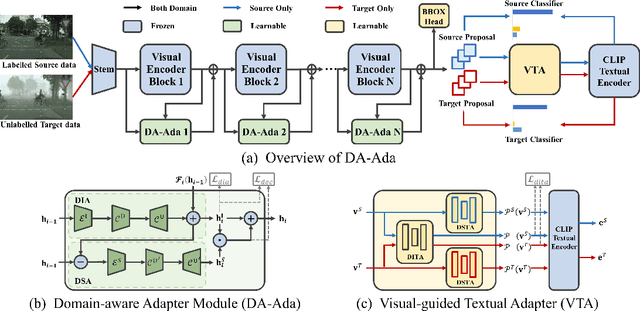
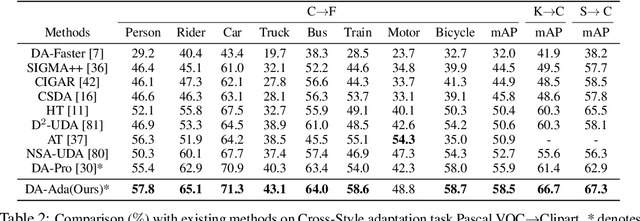

Abstract:Domain adaptive object detection (DAOD) aims to generalize detectors trained on an annotated source domain to an unlabelled target domain. As the visual-language models (VLMs) can provide essential general knowledge on unseen images, freezing the visual encoder and inserting a domain-agnostic adapter can learn domain-invariant knowledge for DAOD. However, the domain-agnostic adapter is inevitably biased to the source domain. It discards some beneficial knowledge discriminative on the unlabelled domain, i.e., domain-specific knowledge of the target domain. To solve the issue, we propose a novel Domain-Aware Adapter (DA-Ada) tailored for the DAOD task. The key point is exploiting domain-specific knowledge between the essential general knowledge and domain-invariant knowledge. DA-Ada consists of the Domain-Invariant Adapter (DIA) for learning domain-invariant knowledge and the Domain-Specific Adapter (DSA) for injecting the domain-specific knowledge from the information discarded by the visual encoder. Comprehensive experiments over multiple DAOD tasks show that DA-Ada can efficiently infer a domain-aware visual encoder for boosting domain adaptive object detection. Our code is available at https://github.com/Therock90421/DA-Ada.
Towards Analyzing and Mitigating Sycophancy in Large Vision-Language Models
Aug 21, 2024Abstract:Large Vision-Language Models (LVLMs) have shown significant capability in vision-language understanding. However, one critical issue that persists in these models is sycophancy, which means models are unduly influenced by leading or deceptive prompts, resulting in biased outputs and hallucinations. Despite the progress in LVLMs, evaluating and mitigating sycophancy is yet much under-explored. In this work, we fill this gap by systematically analyzing sycophancy on various VL benchmarks with curated leading queries and further proposing a text contrastive decoding method for mitigation. While the specific sycophantic behavior varies significantly among models, our analysis reveals the severe deficiency of all LVLMs in resilience of sycophancy across various tasks. For improvement, we propose Leading Query Contrastive Decoding (LQCD), a model-agnostic method focusing on calibrating the LVLMs' over-reliance on leading cues by identifying and suppressing the probabilities of sycophancy tokens at the decoding stage. Extensive experiments show that LQCD effectively mitigate sycophancy, outperforming both prompt engineering methods and common methods for hallucination mitigation. We further demonstrate that LQCD does not hurt but even slightly improves LVLMs' responses to neutral queries, suggesting it being a more effective strategy for general-purpose decoding but not limited to sycophancy.
CodeV: Empowering LLMs for Verilog Generation through Multi-Level Summarization
Jul 16, 2024Abstract:The increasing complexity and high costs associated with modern processor design have led to a surge in demand for processor design automation. Instruction-tuned large language models (LLMs) have demonstrated remarkable performance in automatically generating code for general-purpose programming languages like Python. However, these methods fail on hardware description languages (HDLs) like Verilog due to the scarcity of high-quality instruction tuning data, as even advanced LLMs like GPT-3.5 exhibit limited performance on Verilog generation. Regarding this issue, we observe that (1) Verilog code collected from the real world has higher quality than those generated by LLMs. (2) LLMs like GPT-3.5 excel in summarizing Verilog code rather than generating it. Based on these observations, this paper introduces CodeV, a series of open-source instruction-tuned Verilog generation LLMs. Instead of generating descriptions first and then getting the corresponding code from advanced LLMs, we prompt the LLM with Verilog code and let the LLM generate the corresponding natural language description by multi-level summarization. Experimental results show that CodeV relatively surpasses the previous open-source SOTA by 14.4% (BetterV in VerilogEval) and 11.3% (RTLCoder in RTLLM) respectively, and also relatively outperforms previous commercial SOTA GPT-4 by 22.1% in VerilogEval.
InverseCoder: Unleashing the Power of Instruction-Tuned Code LLMs with Inverse-Instruct
Jul 08, 2024Abstract:Recent advancements in open-source code large language models (LLMs) have demonstrated remarkable coding abilities by fine-tuning on the data generated from powerful closed-source LLMs such as GPT-3.5 and GPT-4 for instruction tuning. This paper explores how to further improve an instruction-tuned code LLM by generating data from itself rather than querying closed-source LLMs. Our key observation is the misalignment between the translation of formal and informal languages: translating formal language (i.e., code) to informal language (i.e., natural language) is more straightforward than the reverse. Based on this observation, we propose INVERSE-INSTRUCT, which summarizes instructions from code snippets instead of the reverse. Specifically, given an instruction tuning corpus for code and the resulting instruction-tuned code LLM, we ask the code LLM to generate additional high-quality instructions for the original corpus through code summarization and self-evaluation. Then, we fine-tune the base LLM on the combination of the original corpus and the self-generated one, which yields a stronger instruction-tuned LLM. We present a series of code LLMs named InverseCoder, which surpasses the performance of the original code LLMs on a wide range of benchmarks, including Python text-to-code generation, multilingual coding, and data-science code generation.
Adversarial Contrastive Decoding: Boosting Safety Alignment of Large Language Models via Opposite Prompt Optimization
Jun 24, 2024Abstract:With the widespread application of Large Language Models (LLMs), it has become a significant concern to ensure their safety and prevent harmful responses. While current safe-alignment methods based on instruction fine-tuning and Reinforcement Learning from Human Feedback (RLHF) can effectively reduce harmful responses from LLMs, they often require high-quality datasets and heavy computational overhead during model training. Another way to align language models is to modify the logit of tokens in model outputs without heavy training. Recent studies have shown that contrastive decoding can enhance the performance of language models by reducing the likelihood of confused tokens. However, these methods require the manual selection of contrastive models or instruction templates. To this end, we propose Adversarial Contrastive Decoding (ACD), an optimization-based framework to generate two opposite system prompts for prompt-based contrastive decoding. ACD only needs to apply a lightweight prompt tuning on a rather small anchor dataset (< 3 min for each model) without training the target model. Experiments conducted on extensive models and benchmarks demonstrate that the proposed method achieves much better safety performance than previous model training-free decoding methods without sacrificing its original generation ability.
Prompt-based Visual Alignment for Zero-shot Policy Transfer
Jun 05, 2024



Abstract:Overfitting in RL has become one of the main obstacles to applications in reinforcement learning(RL). Existing methods do not provide explicit semantic constrain for the feature extractor, hindering the agent from learning a unified cross-domain representation and resulting in performance degradation on unseen domains. Besides, abundant data from multiple domains are needed. To address these issues, in this work, we propose prompt-based visual alignment (PVA), a robust framework to mitigate the detrimental domain bias in the image for zero-shot policy transfer. Inspired that Visual-Language Model (VLM) can serve as a bridge to connect both text space and image space, we leverage the semantic information contained in a text sequence as an explicit constraint to train a visual aligner. Thus, the visual aligner can map images from multiple domains to a unified domain and achieve good generalization performance. To better depict semantic information, prompt tuning is applied to learn a sequence of learnable tokens. With explicit constraints of semantic information, PVA can learn unified cross-domain representation under limited access to cross-domain data and achieves great zero-shot generalization ability in unseen domains. We verify PVA on a vision-based autonomous driving task with CARLA simulator. Experiments show that the agent generalizes well on unseen domains under limited access to multi-domain data.
Luban: Building Open-Ended Creative Agents via Autonomous Embodied Verification
May 24, 2024Abstract:Building open agents has always been the ultimate goal in AI research, and creative agents are the more enticing. Existing LLM agents excel at long-horizon tasks with well-defined goals (e.g., `mine diamonds' in Minecraft). However, they encounter difficulties on creative tasks with open goals and abstract criteria due to the inability to bridge the gap between them, thus lacking feedback for self-improvement in solving the task. In this work, we introduce autonomous embodied verification techniques for agents to fill the gap, laying the groundwork for creative tasks. Specifically, we propose the Luban agent target creative building tasks in Minecraft, which equips with two-level autonomous embodied verification inspired by human design practices: (1) visual verification of 3D structural speculates, which comes from agent synthesized CAD modeling programs; (2) pragmatic verification of the creation by generating and verifying environment-relevant functionality programs based on the abstract criteria. Extensive multi-dimensional human studies and Elo ratings show that the Luban completes diverse creative building tasks in our proposed benchmark and outperforms other baselines ($33\%$ to $100\%$) in both visualization and pragmatism. Additional demos on the real-world robotic arm show the creation potential of the Luban in the physical world.
Assessing and Understanding Creativity in Large Language Models
Jan 23, 2024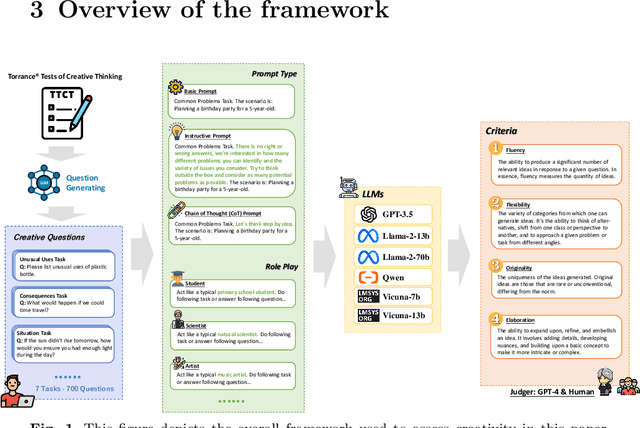
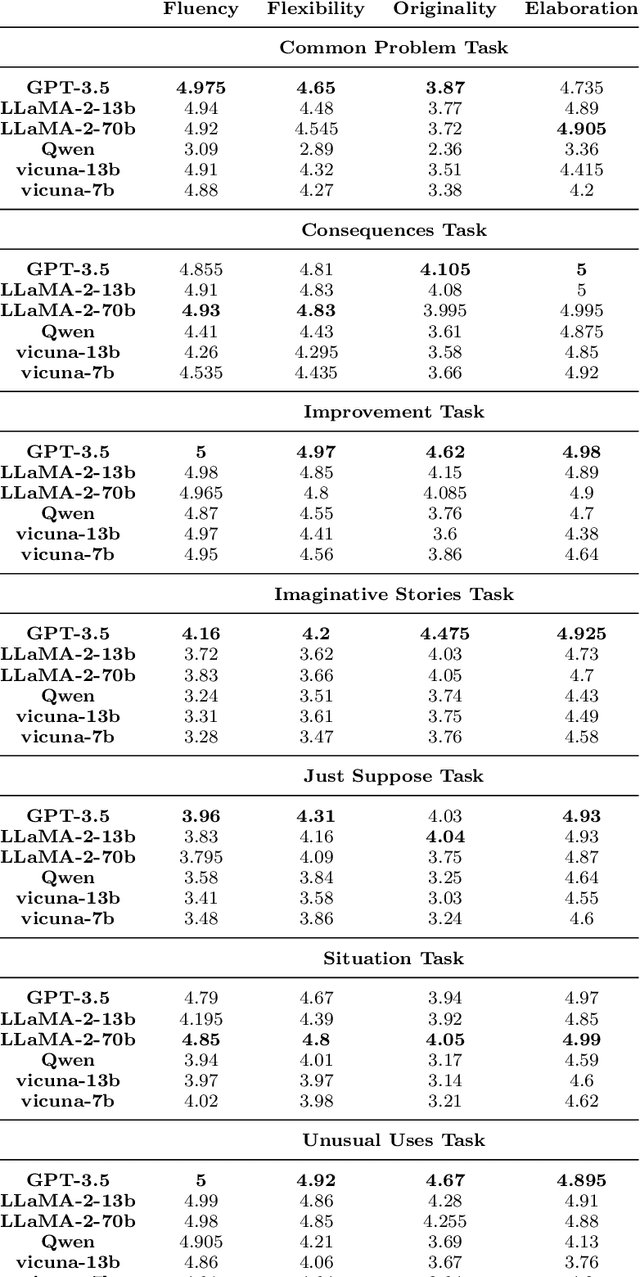
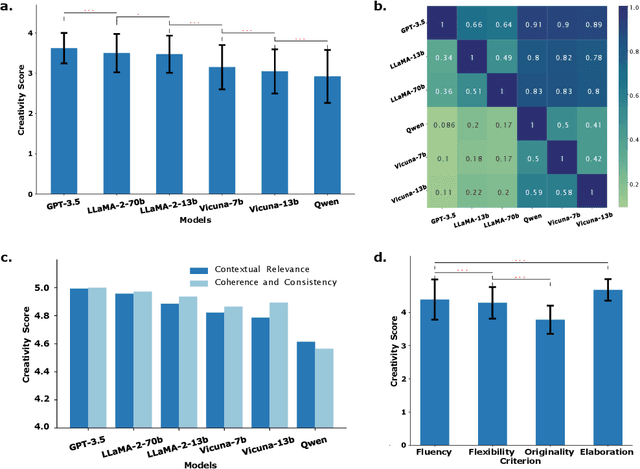
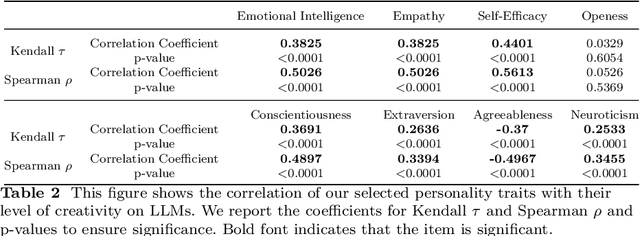
Abstract:In the field of natural language processing, the rapid development of large language model (LLM) has attracted more and more attention. LLMs have shown a high level of creativity in various tasks, but the methods for assessing such creativity are inadequate. The assessment of LLM creativity needs to consider differences from humans, requiring multi-dimensional measurement while balancing accuracy and efficiency. This paper aims to establish an efficient framework for assessing the level of creativity in LLMs. By adapting the modified Torrance Tests of Creative Thinking, the research evaluates the creative performance of various LLMs across 7 tasks, emphasizing 4 criteria including Fluency, Flexibility, Originality, and Elaboration. In this context, we develop a comprehensive dataset of 700 questions for testing and an LLM-based evaluation method. In addition, this study presents a novel analysis of LLMs' responses to diverse prompts and role-play situations. We found that the creativity of LLMs primarily falls short in originality, while excelling in elaboration. Besides, the use of prompts and the role-play settings of the model significantly influence creativity. Additionally, the experimental results also indicate that collaboration among multiple LLMs can enhance originality. Notably, our findings reveal a consensus between human evaluations and LLMs regarding the personality traits that influence creativity. The findings underscore the significant impact of LLM design on creativity and bridges artificial intelligence and human creativity, offering insights into LLMs' creativity and potential applications.
Non-autoregressive Machine Translation with Probabilistic Context-free Grammar
Nov 14, 2023



Abstract:Non-autoregressive Transformer(NAT) significantly accelerates the inference of neural machine translation. However, conventional NAT models suffer from limited expression power and performance degradation compared to autoregressive (AT) models due to the assumption of conditional independence among target tokens. To address these limitations, we propose a novel approach called PCFG-NAT, which leverages a specially designed Probabilistic Context-Free Grammar (PCFG) to enhance the ability of NAT models to capture complex dependencies among output tokens. Experimental results on major machine translation benchmarks demonstrate that PCFG-NAT further narrows the gap in translation quality between NAT and AT models. Moreover, PCFG-NAT facilitates a deeper understanding of the generated sentences, addressing the lack of satisfactory explainability in neural machine translation.Code is publicly available at https://github.com/ictnlp/PCFG-NAT.
Emergent Communication for Rules Reasoning
Nov 08, 2023



Abstract:Research on emergent communication between deep-learning-based agents has received extensive attention due to its inspiration for linguistics and artificial intelligence. However, previous attempts have hovered around emerging communication under perception-oriented environmental settings, that forces agents to describe low-level perceptual features intra image or symbol contexts. In this work, inspired by the classic human reasoning test (namely Raven's Progressive Matrix), we propose the Reasoning Game, a cognition-oriented environment that encourages agents to reason and communicate high-level rules, rather than perceived low-level contexts. Moreover, we propose 1) an unbiased dataset (namely rule-RAVEN) as a benchmark to avoid overfitting, 2) and a two-stage curriculum agent training method as a baseline for more stable convergence in the Reasoning Game, where contexts and semantics are bilaterally drifting. Experimental results show that, in the Reasoning Game, a semantically stable and compositional language emerges to solve reasoning problems. The emerged language helps agents apply the extracted rules to the generalization of unseen context attributes, and to the transfer between different context attributes or even tasks.
 Add to Chrome
Add to Chrome Add to Firefox
Add to Firefox Add to Edge
Add to Edge